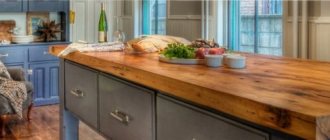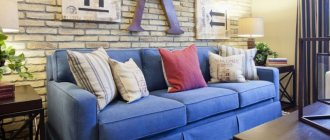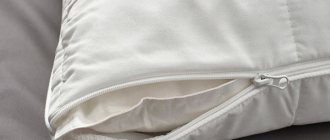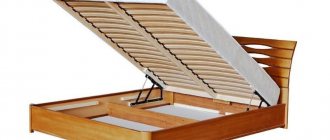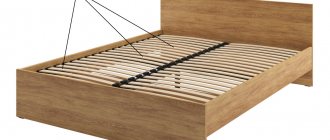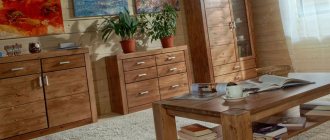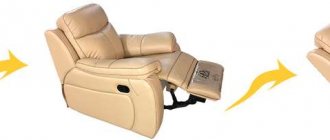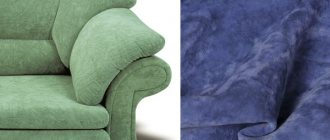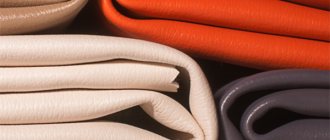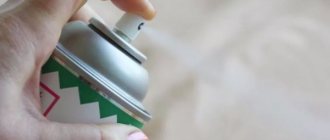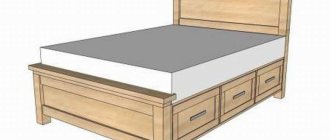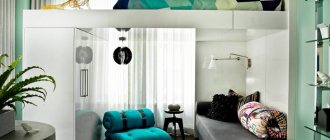The average lifespan of a bed is 10 years. Agree, this is quite a long time. Therefore, you should approach the choice of bed upholstery consciously. You come to the store and... you see that all the options are beautiful, and the consultants only talk about the advantages. Still, fabric or eco-leather? We will tell you how to choose upholstery for your bed so that you will enjoy it for many years, and you will not waste all your nerve cells in the search process.
Advantages of an upholstered bed
Why buy a fabric bed if there are models without any upholstery at all? Interior beds, or upholstered beds, are worth buying for several reasons:
- You often read, work or watch TV series in bed. It is more pleasant and comfortable to lean on a soft headboard than on a wooden panel. In our catalog you will find many options for beds with upholstered headboards.
- The interior lacks coziness. A fabric bed will become the center of the bedroom and create a greater feeling of comfort than a simple fiberboard option.
- It is important for you that the bed matches the interior. There are incredibly many options for colors and textures of fabric upholstery that will match the color of curtains or carpet.
- You want to avoid bruises on the wooden drawers. You have small children and you are worried that they will get hurt on the wooden parts of the bed.
DIY soft headboard
You can make a carriage screed yourself, but it will take a lot of time and effort. For those who are interested, there is a detailed video in this article, and we will look at the simplest option for arranging a smooth pillow.
- For work we will need a furniture stapler, a hammer, a knife and scissors;
- The base is plywood or OSB with a thickness of 10 mm or more or chipboard with a thickness of 16 mm;
- First, the shield is wrapped in foam rubber 3–5 cm thick, after which the foam rubber is fixed on the reverse side with a stapler;
- Next, using the same scheme, we wrap the shield with upholstery material and fasten it on the back side with a stapler;
- We could finish here, but if you want to arrange patterns, then take furniture nails and drive them in a chain according to the given pattern.
Step-by-step diagram for arranging a soft headboard of a bed.
What kind of fabric upholstery is there?
Fabric is the most popular upholstery material. It is chosen for its tactility and variety of colors and textures. Fabric upholstery is distinguished by the degree of naturalness, durability, ease of care and aesthetics. Choosing the wrong bed upholstery is one of the most common mistakes when planning a bedroom. Let's take a closer look at the types of fabric:
Velours
Velor is the softest material among the upholstery options. Velor feels like velvet, and if you run your fingers over it, you will notice a “writing effect” (it changes the direction of the pile and leaves a mark). Furniture made from velor is often used by designers in interiors - long pile adds nobility, and due to the wide palette of colors, velor is easy to fit into the interior.
Velor is a natural and eco-friendly fabric. This fabric is also practical and abrasion resistant. The main disadvantage: it is difficult to remove stains from this fabric on your own.
Velveteen
Corduroy is a dense fabric with a pile, the texture resembles velvet. The main difference from velor is in the height and texture of the pile - in corduroy it is shorter and divided into longitudinal stripes “ribbed”. Corduroy is easy to recognize by the iridescence of color on the surface and its softness. Corduroy does not absorb moisture, so it is easy to clean. The disadvantage of corduroy is that scratches are more noticeable on it than on velor.
Gozhka
Matting is a coarsely woven fabric, similar to burlap. It fits well into Scandi and eco style interiors. The matting is almost impossible to crush, it is very durable.
Jacquard
Thick upholstery fabric that resembles a tapestry due to its voluminous patterns. Jacquard is dense to the touch and does not fade in the sun. Among the shortcomings, scratches and abrasions are very noticeable on this fabric.
Faux suede
Artificial suede is a smooth and dense fabric with short pile that feels no different from natural leather. This suede does not require complicated care - it does not allow moisture to pass through, and even difficult dirt can be removed with a damp brush.
The material has an interesting feature: in the summer, in the heat, it is cool, and in the cold season, on the contrary, it accumulates heat.
Flock
Flock is a short-pile material that is most often confused with velor. The material is waterproof, droplets of water simply remain on the surface. Another plus is high density, and due to this - strength. Flock products are difficult to tear and damage; they are as easy to care for as leather.
It is made by gluing tufts of pile onto a fabric base. One of the disadvantages is that the flock needs to be cleaned with a vacuum cleaner quite often.
Chenille
Dense material with a pleasant velvety structure. It does not shed or fray. This fabric feels fluffy to the touch and resembles corduroy.
Made from natural or synthetic materials. Due to their combination, a high density of the material is achieved, which means resistance to scratches and abrasions.
How to choose a bed? Tips and tricks.
The main criterion by which a bed is usually chosen is, of course, design. First of all, the buyer chooses a bed so that it matches the interior of the apartment and harmoniously combines both in style and color.
What should you pay attention to when choosing a bed? Of course, depending on the size of the bed. The most common sizes are the following: 120x200, 140x200, 160x200 and 180x200 cm. Select the size of the bed so that you feel comfortable and comfortable on the bed. Most specialized stores provide the opportunity to lie on the bed before purchasing in order to determine exactly what size bed will be optimal for you. Do not ignore this opportunity, because the bed is purchased for a long time and you should be comfortable on it for many years.
When purchasing a bed, it is important to pay attention to the mattress base. Beds can be equipped with an orthopedic or rigid base, or they can be sold without a base. If the bed is sold without a base, it must be purchased separately - this is an additional cost for the buyer.
It is recommended to purchase beds with a reinforced orthopedic base based on a durable metal frame with wooden slats. This base allows you to fully reveal the orthopedic properties of the mattress and ensures its ventilation. Pay attention to the quality of the lamellas themselves - they must be sufficiently strong and elastic, at least 50 mm wide, and the distance between the lamellas is no more than 70 mm, and the smaller this distance, the better. The bases are available with a different number of support legs (from 4 to 9), the more legs at the base, the better.
Beds with a rigid base are also common. The base is a durable metal structure with laminated MDF sheets laid on top. This base is characterized by high load characteristics and has excellent reliability. They are recommended for people with heavy weight.
Recently, orthopedic bases with a lifting mechanism and a niche for linen have become very popular. Thanks to special gas shock absorbers, the mattress along with the orthopedic lattice can be easily raised, and bed linen and other things can be folded into a spacious niche at the base of the bed. This solution allows you to increase the functional properties of the bed and rationally use the free space in the bedroom.
What material should I buy the bed from ? Leather, eco-leather, wood or metal? In this case, when choosing a bed there are no special recommendations, the choice depends solely on your personal preferences, choose the bed that you like best and suits your interior. Before purchasing, carefully inspect the selected model, touch the backrest, check the strength of the backrest and other parts of the bed.
What types of beds are there? Beds are distinguished by the material from which they are made or finished. The most popular beds are made of MDF, solid wood, metal, beds trimmed with leather, eco-leather, vinyl leather. Each of these materials has its own characteristics, advantages and disadvantages.
Solid wood beds. Solid wood is considered a prestigious and environmentally friendly material for making furniture. The undoubted advantage of the array is its naturalness. A solid wood bed looks beautiful and creates a positive feeling when touched - the wood is warm and pleasant to the touch. Wooden furniture will last for decades. Disadvantages: sensitivity to temperature changes, high or low humidity.
Metal beds. The main characteristics of metal beds are their high strength and reliability in operation, as well as their brilliant appearance. The metal is not subject to change in shape and can withstand high mechanical loads. And among other things, elegant wrought-iron beds will become an exquisite decoration of your bedroom interior. Cons: the metal is cold to the touch, a forged bed does not suit every interior.
Beds made of wood and metal. A good solution for a modern bedroom, this bed combines the strength of metal, the warmth of natural wood and low cost.
Beds with genuine leather trim. Genuine leather is a high-quality and durable material; it has high breathability, allowing furniture to “breathe.” Leather trim has a long service life, does not absorb dirt, and is resistant to moisture and temperature fluctuations. Since leather is an expensive material, usually only the headboard of the bed is made from it, and the sides are finished with artificial leather, which completely matches the color and texture of the headboard. You should know that products made from genuine leather must be properly cared for - wiped 2-3 times a year with special products that moisturize and preserve the leather, which will avoid premature wear and aging.
How to care for fabric
The main rule for caring and cleaning any fabric furniture is not to use chlorine-containing or concentrated compounds, as well as products with abrasive particles.
- Jacquard. To remove dust, use a vacuum cleaner with a soft brush or a cloth. Jacquard fabric should not be rubbed too hard.
- Matting. Remove dust with a vacuum cleaner, stains with specialized foam for cleaning furniture.
- Velor and Velvet. Dust is removed with a vacuum cleaner, but with a soft attachment. Stains can be removed using specialized furniture sprays. Smooth the fleecy surface with a soft brush so that after cleaning the furniture looks like new.
- Flock. Avoid products that contain alcohol. It is better to use water with a temperature no higher than 40 degrees and a soap solution. Wipe off dust with a fluffy cloth or a vacuum cleaner with a soft attachment only.
- Faux suede. It is better to clean with a special brush. Dust can be removed with a fluffy cloth or a vacuum cleaner with a soft attachment.
- Chenille. To remove dirt, use soap suds or a vacuum cleaner. It is better to use water to a minimum.
Characteristics of upholstery fabrics
All fabrics used for furniture are conventionally divided into several categories that meet the following criteria:
- appearance;
- strength;
- performance characteristics;
- price.
The denser the material is and the higher its cost, the higher the category it belongs to.
Very often, the buyer chooses the appearance of the fabric as the main reference. The first thing that catches your eye is the color. When choosing it, you should take into account the overall color scheme of the room in which the sofa will be located. You should also pay attention to the presence of a picture. Plain fabric looks more classic and stylish, but the pattern will not fit into every interior style. Its advantage is that stains are not so noticeable on patterned fabric.
A very important characteristic is the durability of the material, because it determines how long the sofa will serve you. If you choose a low-quality but cheap option, then soon you will have to reupholster it or, in the worst case, purchase a new model. How long you can use the material, as well as its ability to maintain its original appearance, depends on:
- fiber composition;
- production technologies;
- the presence of additional impregnation and processing;
- other criteria.
An important characteristic is also the comfort of the fabric. This means tactile sensations when you touch it with your hand. It can be warmth, softness, velvety and so on.
Eco leather is...
Eco-leather is a type of fabric very similar to natural leather. He copies it both visually and to the touch.
This material is obtained by applying porous polyurethane to a base of dense fabric. The result is a wear- and temperature-resistant fabric that is highly breathable.
Depending on its resistance to tearing and abrasion, eco-leather can be divided into the following subcategories:
- Economy Soft, stretchy material with a cotton and polyester backing. Cannot withstand damage from sharp objects.
- Standard. High density material, more than 25 thousand abrasion cycles.
- Premium Ultra-durable, breathable material, resistant to scratches and stains.
Description of work
Decide on the materials and start creating your own masterpiece from soft squares.
Step-by-step description of the work:
- We cut about 60 squares from plywood or cardboard - the size and size depend on the dimensions of the future headboard.
- We cut out squares of the same size from foam rubber, and slightly larger squares from batting - with an allowance for the overlap on top of the foam rubber.
- Lastly, we cut out a square of fabric, taking into account that its edges should go to the back side for fixation.
- Now we assemble the squares in this order - plywood, foam rubber, batting, fabric.
- We secure the fabric on the back side of the product using a stapler.
- We prepare a base from plywood, MDF or durable cardboard according to the size of all the squares folded together.
- We attach our squares to the base with glue or self-tapping screws.
This headboard is hung on the wall using special hooks. Using this technique, you can create both a plain headboard and a patchwork style.
What to choose: fabric or eco-leather
After a detailed investigation on the site or questioning a consultant, are you still undecided on the type of upholstery? Here are a few parameters to help you make your choice:
- External characteristics. The material suits you visually and to the touch, and fits into the interior.
- Wear resistance. You have studied the product data sheet and understand that the number of abrasion cycles suits you. The best option to buy are models with a rating of 20,000 abrasion cycles.
- Density. Choose a material with a rating of 200 g/m. This is also indicated in the upholstery passport.
- Formation of pellets. On natural fabric with long pile, pilling appears more often.
- Color fastness. The material is resistant to sunlight and friction.
Comparison of fabric and eco-leather
| Parameter | Textile | Eco leather |
| Design | Big variety | Difficult to distinguish from natural |
| Variety of colors | Yes | Yes |
| Life time | 5-7 years | 8-10 years |
| Tactility | Feels different depending on the fabric. There are fabrics with a pleasant velvety structure. | Soft surface, pleasant texture Due to poor thermoregulation, the surface is cold and becomes very hot upon contact with the skin. |
| Absorbs moisture | Absorbs moisture | Repels water |
| Breathable surface | Yes | Yes, but worse than fabric |
| Care | Specific care depending on the type of fabric. | Easy to care for |
| Wear resistance | Yes | May crack if exposed to direct sunlight. |
| Stain resistance | Difficult to remove stains | Easy to care for |
| Static charge | Eat | No |
| Scratch resistance | Depends on the type of fabric | Depends on the eco-leather category |
Stylish solutions in the interior
Here are some attractive interiors that feature a stylish eco-leather bed:
- A cozy white bed with a high soft headboard and small furniture nails will look impressive against the background of a cream wall and a window with soft chocolate curtains. You can lay a brown laminate on the floor and complement it with a pastel-colored carpet. In such an environment, a white TV stand, as well as a black table lamp and dark coffee-colored pillows will look harmonious.
- A light brown leatherette bed on small dark legs can be placed in a room with gray walls and a light brown floor. You can complement the interior with beige bed linen, black and white paintings above the head of the bed and a fluffy light gray carpet.
- A white eco-leather bed with chrome legs will find its place in a room with dark gray walls, a dark brown floor and a white ceiling. Near the bed you can place a white chest of drawers with a rectangular mirror and white bedside tables. Complete the ensemble with a gray floor rug, coffee curtains on the windows, soft gray pillows and beige wall art.
- A beautiful white bed with a high headboard will look great against the background of chocolate walls and a light laminate floor. Decorative vases in white and blue will find their place next to the bed. Upholstered furniture should be complemented with blue bedding and white wall lamps.
- A cream eco-leather bed can be placed in a room with soft coffee walls and dark wood floors. The sleeping area should be complemented with light bedside tables of elegant shapes and small white lamps. A beige ottoman will look harmonious in front of it.
You can make a bed from eco-leather with your own hands. See all about this in the video below.
Conclusion
Modern soft upholstery can be beautiful and durable, both in fabric and eco-leather. In addition to the advantages of upholstery, consider the features of the interior and your preferences. For a layout with a separate bedroom, fabric upholstery is suitable. It will provide the necessary ventilation and prevent the bed linen from slipping. In an apartment - studio, where the bed also serves as a sofa, it is better to choose eco-leather - the upholstery will better withstand the test of stains and will not absorb the aroma that appears when cooking. If you have pets or children, eco-leather is unlikely to last long. It is better to choose a thick fabric that will withstand the test of claws.
Main advantages
Manufacturers of upholstered furniture have stepped forward so much that choosing suitable furniture today is not difficult. Beds vary in appearance, design, size and pricing. There are two types of soft beds: standard classics and models with a lifting device. The first option is installed in large bedrooms. In smaller rooms, soft beds with a lifting mechanism or built-in beds in the wall or closet are installed. The models have a more compact appearance. Soft beds have some advantages:
- The interior of the rest room takes on a new design;
- Sleep becomes more comfortable;
- There are additional places for things;
- The durable and reliable design of the bed with lifting blocks will allow you to compactly fold things in the interior space of the furniture;
- Long product life.
Along with these advantages, there is another plus - the feeling of a soft wall. The upholstery is made of various materials in any color scheme, thanks to which the buyer can choose the appropriate model for his room. In some cases, if there is a lack of space, installing a transformable bed eliminates the chest of drawers in the bedroom, which frees up additional space.
At the base of upholstered furniture there are mattresses that differ in size, quality of material and number of layers. This helps the buyer choose a specimen that is more suitable due to physiological needs.
Additional recommendations
When replacing upholstery, you must carefully monitor the tension of the material and constantly smooth it out to prevent the formation of unnecessary folds. If the headboard is embossed and figured, the fabric should be trimmed and tucked in the right places.
Many people prefer to make removable covers for their furniture, which are an excellent replacement for upholstery. In addition, you can make several similar products at once and change them from time to time, while updating the appearance of the bed.
You can also decorate the bed upholstery yourself using fabric-covered buttons and nails with original heads.
Natural materials
Let's consider the most popular upholstery materials made from environmentally friendly raw materials. These fabrics are the safest for health; they will not harm either allergy sufferers or people suffering from bronchopulmonary diseases. Natural textiles breathe, absorb moisture from the air, and reduce static electricity.
Cotton
Cotton cover is soft and tactilely pleasant
Popular textiles made from plant fibers of cotton. This matter is one of the most common in the world, known since ancient times. It is used in almost all industries.
The advantages of cotton are its hygroscopicity and breathability. The matter is harmless and safe. It lends itself well to dyeing, so there are dozens of colors and prints.
Many people like the low price. The approximate service life with average wear will be no more than 5 years. Buy a sofa with cotton upholstery only if it is coated with a special anti-wear compound.
In addition to its short service life, an important disadvantage of cotton is flammability. It ignites very quickly and smokes heavily. Good upholstery fabric must be treated with fire-resistant impregnation.
Jacquard
Jacquard fabric has a relief texture
Jacquard fabric is created through complex weaving, which simultaneously involves more than 24 intertwining threads. This allows you to create exquisite and ornate designs, unusual patterns, and intricate ornaments. The texture of such matter is very dense and embossed.
It is incorrect to call the fabric jacquard, as it is more of a weaving method. Therefore, both natural and artificial threads can participate in it. For furniture textiles, cotton, linen, wool or silk fibers are often used, combining them with synthetics.
Polyester makes the material strong, strong and durable. It does not fade in the sun and is highly breathable. Jacquard is treated with dust-repellent compounds, which makes it easier to clean.
Among the disadvantages, we note the high price, difficulty in care (the fabric does not like wet washing), and it is also slippery and cool to the touch.
Tapestry
The tapestry looks expensive and solid
A textile fabric created by weaving many colored threads and simultaneously folding them into a pattern. The material turns out to be heavy, dense, two or three layers. The art of creating tapestries is the oldest applied craft, known since the times of the Egyptian pharaohs.
This upholstery has a very long service life and looks rich and expensive. Like jacquard, it contains a small percentage of synthetic fibers to improve physical properties. The disadvantage is the tendency to abrasion and fading in direct sunlight.
Fragile silk helps create a sophisticated atmosphere
Smooth natural silk is used to decorate antique furniture or sofas in an elaborate baroque style. The canvas is famous for its hypoallergenic and antistatic qualities. And it also looks chic, expensive, elegant.
Unfortunately, silk is very fragile and is not suitable for furniture that is used every day. The material is cool to the touch, this nuance is also considered a disadvantage.
Ideal for a study or office
Genuine leather is the most expensive and noble way to decorate your sofa. Such furniture is placed in living rooms, offices, and official rooms. Leather gives it a spectacular appearance, creates an atmosphere of prosperity, and makes a solid impression.
It can be matte, rough, glossy. There are many colors, options with a combination of shades. Gold or silver embossing, logos, and fabric stitching look good on the leather.
Source: krrot.net
